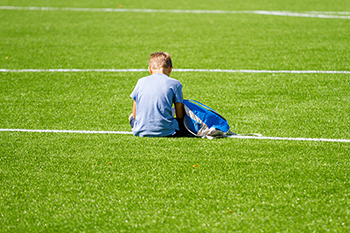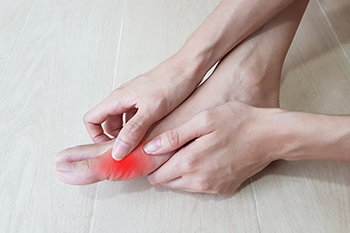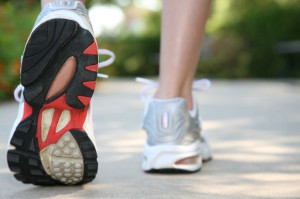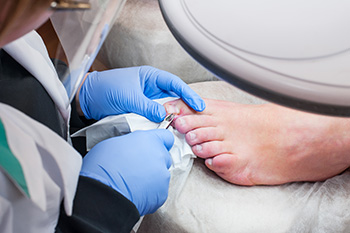Dallas (214) 340-8885
Athens (903) 677-9090
Gun Barrel City (903) 887-4341
Dallas (214) 340-8885
Athens (903) 677-9090
Gun Barrel City (903) 887-4341
Foot and ankle injuries are common among athletes and those who exercise frequently. Most of these injuries are non-life-threatening and can heal in weeks with proper treatment and care. Serious injuries, however, require urgent medical treatment.
Common minor injuries include ankle sprains, ankle strains, Achilles tendonitis, plantar fasciitis, stress fractures, and turf toe. An ankle sprain is when the ligaments in the ankle have either become stretched or torn. When the muscle or tendon is stretched or torn, it is an ankle strain. When the big toe is sprained, it is known as turf toe. Achilles tendonitis is the overuse and inflammation of the Achilles tendon. Plantar fasciitis is the inflammation of the plantar fascia and generally occurs from overuse in athletics. Stress fractures are also caused from overuse and are small cracks in the bone.
Achilles tendon ruptures are common, but more serious. This injury occurs when the Achilles tendon, the largest tendon in the body, ruptures. In most cases, this causes severe pain and difficulty walking; some who have experienced this injury have reported, however, no signs or symptoms. A laceration is a deep cut that can occur anywhere on the body. Lacerations on the foot are rarer, but can occur from things like metal cleats landing on the foot.
Treatment options cover a wide range of methods based upon the injury and its severity. Conditions like plantar fasciitis, stress fractures, Achilles tendonitis, turf toe and ankle sprains/ strains can heal on their own without immediate medical care, but seeing a podiatrist to monitor the injury is always recommended. Following the RICE (Rest, Icing, Compression, and Elevation) protocol is generally enough to treat minor injuries. This means resting the foot by either keeping pressure off the foot or not walking at all. Icing the injury will help reduce swelling and pain. Compressing the wound with a wrap will immobilize and help promote healing. Finally, keeping the wound elevated will also reduce swelling and also help the healing process.
It is important to note that even minor injuries can vary in severity, with grade one being a minor injury and grade three requiring urgent care by a podiatrist. Achilles tendon ruptures and lacerations on the foot generally require urgent medical care and treatment options that need a podiatrist. These could include imaging tests, stitches for cuts, rehabilitation, and casts or braces. Every case is different, however, so it is always recommended to see a podiatrist when pain in the foot does not disappear.
 Foot and ankle injuries are common among kids and adolescents who play sports, ranging from congenital variants to acute and chronic injuries. Congenital variants can include structural abnormalities present at birth. Osteochondroses, a group of disorders affecting the growth of bones in children and adolescents, can cause pain and swelling. Acute injuries, such as fractures and sprains, and chronic injuries, like stress fractures and tendonitis, are prevalent due to the repetitive stress of sports activities. Soft tissue injuries, including strains and ligament tears, are also frequent. Additionally, infections can complicate injuries if not properly treated. Podiatrists must consider systemic diseases such as inflammatory arthritis when a pediatric athlete presents with unexplained pain and swelling in one or more joints. Adolescents tend to sustain more injuries than younger children due to their increased participation in high-intensity sports and the physical changes during growth spurts. If your child has sustained a foot or ankle injury from playing sports or complains of associated pain, it is suggested that you schedule an appointment with a podiatrist for a proper diagnosis and treatment.
Foot and ankle injuries are common among kids and adolescents who play sports, ranging from congenital variants to acute and chronic injuries. Congenital variants can include structural abnormalities present at birth. Osteochondroses, a group of disorders affecting the growth of bones in children and adolescents, can cause pain and swelling. Acute injuries, such as fractures and sprains, and chronic injuries, like stress fractures and tendonitis, are prevalent due to the repetitive stress of sports activities. Soft tissue injuries, including strains and ligament tears, are also frequent. Additionally, infections can complicate injuries if not properly treated. Podiatrists must consider systemic diseases such as inflammatory arthritis when a pediatric athlete presents with unexplained pain and swelling in one or more joints. Adolescents tend to sustain more injuries than younger children due to their increased participation in high-intensity sports and the physical changes during growth spurts. If your child has sustained a foot or ankle injury from playing sports or complains of associated pain, it is suggested that you schedule an appointment with a podiatrist for a proper diagnosis and treatment.
Ankle and foot injuries are common among athletes and in many sports. They can be caused by several problems and may be potentially serious. If you are feeling pain or think you were injured in a sporting event or when exercising, consult with Dr. Jonathan Kletz from Texas Foot Works. Our doctor will assess your condition and provide you with quality foot and ankle treatment.
Common Injuries
The most common injuries that occur in sporting activities include:
Symptoms
Symptoms vary depending upon the injury and in some cases, there may be no symptoms at all. However, in most cases, some form of symptom is experienced. Pain, aching, burning, bruising, tenderness, tightness or stiffness, sensation loss, difficulty moving, and swelling are the most common symptoms.
Treatment
Just as symptoms vary depending upon the injury, so do treatment options. A common treatment method is known as the RICE method. This method involves rest, applying ice, compression and elevating the afflicted foot or ankle. If the injury appears to be more serious, surgery might be required, such as arthroscopic or reconstructive surgery. Lastly, rehabilitation or therapy might be needed to gain full functionality in the afflicted area. Any discomfort experienced by an athlete must be evaluated by a licensed, reputable medical professional.
If you have any questions, please feel free to contact one of our our offices located in Dallas, Athens, and Gun Barrel City, TX . We offer the newest diagnostic and treatment technologies for all your foot care needs.
Gout, typically found in diabetic patients, is an unusually painful form of arthritis caused by elevated levels of uric acid in the bloodstream. The condition typically strikes the big joint on the big toe. It has also been known to strike the knees, elbows, fingers, ankles and wrists—generally anywhere that has a functioning, moving joint.
The high level of uric acid in a person’s bloodstream creates the condition known as hyperuricema—the main cause of gout. Genetic predisposition occurs in nine out of ten sufferers. The children of parents who suffer gout will have a two in ten chance of developing the condition as well.
This form of arthritis, being particularly painful, is the leftover uric acid crystallizing in the blood stream. The crystallized uric acid then travels to the space between joints where they rub, causing friction when the patient moves. Symptoms include: pain, redness, swelling, and inflammation. Additional side effects may include fatigue and fever, although reports of these effects are very rare. Some patients have reported that pain may intensify when the temperature drops, such as when you sleep.
Most cases of gout are easily diagnosed by a podiatrist’s assessment of the various symptoms. Defined tests can also be performed. A blood test to detect elevated levels of uric acid is often used as well as an x-ray to diagnose visible and chronic gout.
Treatment for gout simply means eliminating symptoms. Non-steroid anti-inflammatory drugs or NSAIDs (Colchicine and other corticosteroid drugs, etc.) will quell the redness, the swelling, and the inflammation. However, managing your diet, lifestyle changes, and using preventative drugs are all helpful toward fully combating the most severe cases.
Those that lead an inactive lifestyle are at a higher risk for gout. Any amount of exercise decreases the probability of repeat encounters with the condition. Reducing your consumption of red meat, sea food, and fructose-sweetened drinks also reduces the likelihood of chronic gout as well.
Ingesting Vitamin C, coffee, and particular dairy products can help with maintaining a healthy lifestyle. There are new drugs out on the market that inhibit the body’s production of uric acid-producing enzymes. However, reducing or eliminating your overall levels of uric acid is the best remedy to ensuring you lead a gout-free life.
 Gout, a form of arthritis caused by the buildup of uric acid crystals in the joints, affects both men and women, though it is more prevalent in men. However, women are increasingly affected, especially after menopause. Before menopause, estrogen helps to lower uric acid levels, providing a protective effect. After menopause, the decline in estrogen levels leads to higher uric acid levels, increasing the risk of gout. Women with gout often experience symptoms in different joints compared to men, with a higher likelihood of affecting the knees and wrists. Additionally, women may face a delayed diagnosis, as gout is traditionally associated with men. Understanding the gender differences in gout can lead to better awareness and treatment options for women, ensuring timely management and improved quality of life. Gout generally affects the joints and the big toe and can produce a significant amount of pain and discomfort. If you have this type of foot pain, it is strongly suggested that you visit a podiatrist who can help you to manage this condition.
Gout, a form of arthritis caused by the buildup of uric acid crystals in the joints, affects both men and women, though it is more prevalent in men. However, women are increasingly affected, especially after menopause. Before menopause, estrogen helps to lower uric acid levels, providing a protective effect. After menopause, the decline in estrogen levels leads to higher uric acid levels, increasing the risk of gout. Women with gout often experience symptoms in different joints compared to men, with a higher likelihood of affecting the knees and wrists. Additionally, women may face a delayed diagnosis, as gout is traditionally associated with men. Understanding the gender differences in gout can lead to better awareness and treatment options for women, ensuring timely management and improved quality of life. Gout generally affects the joints and the big toe and can produce a significant amount of pain and discomfort. If you have this type of foot pain, it is strongly suggested that you visit a podiatrist who can help you to manage this condition.
Gout is a foot condition that requires certain treatment and care. If you are seeking treatment, contact Dr. Jonathan Kletz from Texas Foot Works. Our doctor will treat your foot and ankle needs.
What Is Gout?
Gout is a type of arthritis caused by a buildup of uric acid in the bloodstream. It often develops in the foot, especially the big toe area, although it can manifest in other parts of the body as well. Gout can make walking and standing very painful and is especially common in diabetics and the obese.
People typically get gout because of a poor diet. Genetic predisposition is also a factor. The children of parents who have had gout frequently have a chance of developing it themselves.
Gout can easily be identified by redness and inflammation of the big toe and the surrounding areas of the foot. Other symptoms include extreme fatigue, joint pain, and running high fevers. Sometimes corticosteroid drugs can be prescribed to treat gout, but the best way to combat this disease is to get more exercise and eat a better diet.
If you have any questions please feel free to contact one of our our offices located in Dallas, Athens, and Gun Barrel City, TX . We offer the newest diagnostic and treatment technologies for all your foot and ankle needs.
Choosing the right running shoes for you is an important part of running. A good pair of running shoes will make the running experience more enjoyable for you and prevent potential injury.
Poorly-fitted shoes can increase the risk of injury in runners substantially. Common injuries from running with poor quality shoes include shin splints, sprained ankles, Achilles tendinitis, stress fractures, plantar fasciitis and more. This is due to the fact that bad shoes do not provide proper foot support, can increase pronation (how much the foot rolls when hitting the ground), have little to no cushioning, do not allow the feet to breath, and do not provide enough flex and rigidity in the right parts.
When looking for running shoes, first, determine where you will be running. If you are a trail runner, then pick trail shoes. If you run on concrete and asphalt, then regular running shoes are the best choice. When trying on shoes, its best to go at the end of the day as feet grow during the day and shrink after a night of sleep. Shoes should be more rigid towards the back of the foot while being more flexible up where the toes are. The toe box should provide enough room for the toes to move freely. The overall fit should be snug, not too tight but not too loose. A good pair of running shoes should also provide enough arch support for your foot type. If you experience overpronation or under-pronation while running, try to find a pair of shoes that will help correct this with different sole patterns. Finally, try to find a pair of shoes that allow the feet to breathe like nylon mesh or synthetic leather.
Don’t forget about the socks either. Socks that hold too much moisture can lead to athlete’s foot. Socks should be breathable so that your feet can air out and breathe. Synthetic socks wick away moisture like sweat. If you tend to run a lot, having a second pair of shoes that you can wear while you let the first pair air out is smart. Just don’t forget to replace your shoes after about every 300 to 500 miles.
Before you start running, it is advised to see a podiatrist to see if running is right for you. They can also offer good advice on how to run and what to look for in a pair of running shoes. If you have flat feet or poorly supported ones, they can also offer custom-made orthotics that will help give your feet the support they need.

When it comes to running, selecting the appropriate footwear is essential for comfort, performance, and injury prevention. For long-distance running, cushioned shoes with ample support are ideal to absorb shock and reduce fatigue, enhancing endurance. Trail running demands shoes with rugged outsoles and superior traction to navigate uneven terrain and provide stability on rocky paths. If you are into sprinting or track running, lightweight shoes with minimal cushioning and a snug fit promote agility and speed. Cross-training shoes offer versatility for various activities, blending features suitable for running, jumping, and lateral movements. For those with overpronation or flat feet, motion-control shoes with reinforced arch support help correct gait imbalances and prevent injuries. Conversely, neutral shoes suit runners with normal pronation, offering balanced cushioning and support. If you have developed pain from wearing the wrong type of running shoes, it is suggested that you visit a podiatrist who can treat any foot ailment, and educate you about what type of shoes to purchase for your running style.
You should always make sure your running shoes fit properly in order to avoid injury. For more information, contact Dr. Jonathan Kletz from Texas Foot Works. Our doctor can provide the care you need to keep you pain-free and on your feet.
Choosing the Right Running Shoe for Your Foot Type
Improper shoe sizing can cause a myriad of problems for your feet. Shoes that don’t fit you properly can lead to muscular imbalances in your body, which can result in foot, knee, and hip injuries.
Tips for Finding the Right Running Shoe
If you have any questions please feel free to contact our one of our our offices located in Dallas, Athens, and Gun Barrel City, TX . We offer the newest diagnostic and treatment technologies for all your foot and ankle needs.
An ingrown toenail is a nail that has curved downward and grows into the skin. This typically occurs at the nail borders, or the sides of the nail. As a result, pain, redness, swelling, and warmth may occur in the toe. If a break in the skin forms due to the ingrown nail, bacteria may enter and cause an infection in the area; this is typically characterized by a foul odor and drainage.
Ingrown toenails have multiple reasons for developing. In many instances, the condition is a result of genetics and is inherited. The most common cause, however, is improper trimming; cutting the toenails too short forces the skin beside the nail to fold over. An ingrown toenail can also develop due to trauma, such as stubbing the toe, having an object fall on the toe, or participating in activities that involve repeated kicking or running. Wearing shoes that are too tight or too short can also cause ingrown toenails.
Treatment for an ingrown toenail varies between patients and the severity of the condition. Milder cases that don’t involve infection or other medical conditions can benefit from soaking the feet in room-temperature water and gently massaging the side of the nail. In most cases, however, it is best to see your podiatrist for thorough and proper treatment. After examining your toe, your podiatrist may prescribe oral antibiotics to clear the infection if one is present. Surgical removal of either a portion of the nail or the entire nail may also be considered. In some cases, complete removal or destruction of the nail root may be required. Most patients who undergo nail surgery experience minimal pain afterward and can return to normal activity the following day.
Ingrown toenails can be prevented with proper nail trimming and by avoiding improper-fitting shoes. When cutting the toenails, be sure that you are cutting in a straight line and avoid cutting them too short. Shoes should not be too short or tight in the toe box.

An ingrown toenail occurs when the edge of the nail grows into the surrounding skin, leading to pain, swelling, and potential infection. This common condition can arise from improper nail trimming, wearing tight shoes, trauma, or naturally curved nails. While some may attempt self-care remedies, seeking professional assistance from a podiatrist is vital for safe, effective relief and treatment. Podiatrists possess the expertise to accurately diagnose the severity of the ingrown toenail and recommend appropriate interventions. Treatment methods may include gentle nail trimming, lifting the nail edge, or in severe cases, surgical procedures to remove the ingrown portion of the nail. Ignoring an ingrown toenail or attempting amateur treatments can make the problem worse, leading to complications such as infection or chronic pain. It is suggested that you make an appointment with a podiatrist for tailored treatment to alleviate discomfort from an ingrown toenail.
Ingrown toenails may initially present themselves as a minor discomfort, but they may progress into an infection in the skin without proper treatment. For more information about ingrown toenails, contact Dr. Jonathan Kletz of Texas Foot Works. Our doctor can provide the care you need to keep you pain-free and on your feet.
Ingrown Toenails
Ingrown toenails are caused when the corner or side of a toenail grows into the soft flesh surrounding it. They often result in redness, swelling, pain, and in some cases, infection. This condition typically affects the big toe and may recur if it is not treated properly.
Causes
You are more likely to develop an ingrown toenail if you are obese, have diabetes, arthritis, or have any fungal infection in your nails. Additionally, people who have foot or toe deformities are at a higher risk of developing an ingrown toenail.
Symptoms
Some symptoms of ingrown toenails are redness, swelling, and pain. In rare cases, there may be a yellowish drainage coming from the nail.
Treatment
Ignoring an ingrown toenail can have serious complications. Infections of the nail border can progress to a deeper soft-tissue infection, which can then turn into a bone infection. You should always speak with your podiatrist if you suspect you have an ingrown toenail, especially if you have diabetes or poor circulation.
If you have any questions, please feel free to contact one of our our offices located in Dallas, Athens, and Gun Barrel City, TX . We offer the newest diagnostic and treatment technologies for all your foot care needs.